International Journal of Computer Network and Information Security @ijcnis
Статьи журнала - International Journal of Computer Network and Information Security
Все статьи: 1177
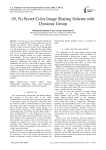
(N, N) Secret Color Image Sharing Scheme with Dynamic Group
Статья научная
In recent years, secure information sharing has become a top requirement for many applications such as banking and military. Secret Sharing is an effective method to improve security of data. Secret Sharing helps to avoid storing data at a single point through dividing and distributing "shares" of secrets and recovering it later with no loss of original quality. This paper proposes a new Secret Sharing scheme for secure transmission of color images. The key features of this scheme are better visual quality of the recovered image with no pixel expansion, eliminating half toning of color images, eliminating the need for code book to decrypt images since reconstruction is done through XOR ing of all images and non-requirement of regeneration of shares for addition or deletion of users leading to less computational complexity. Besides these advantages, this scheme also helps to renew shares periodically and is highly beneficial in applications where data has to be stored securely in a database.
Бесплатно
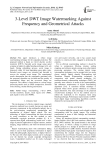
3-Level DWT Image Watermarking Against Frequency and Geometrical Attacks
Статья научная
This paper introduces a robust image watermarking technique for the copyright protection. The proposed method is based on 3-level discrete wavelet transform (DWT). Encoded secret image using spiral scanning is hidden by alpha blending technique in LL sub bands. During embedding process, secret image is dispersed within LL band depending upon alpha value. Encoded secret images are extracted and decoded to recover the original secret image. The experimental results demonstrate that the watermarks generated with the proposed algorithm are invisible and the quality of watermarked image and the recovered image are improved. The scheme is found robust to various image processing attacks such as JPEG compression, Gaussian noise, blurring, median filtering and rotation.
Бесплатно
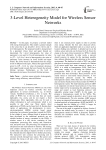
3-Level Heterogeneity Model for Wireless Sensor Networks
Статья научная
In this paper, we propose a network model with energy heterogeneity. This model is general enough in the sense that it can describe 1-level, 2-level, and 3-level heterogeneity. The proposed model is characterized by a parameter whose lower and upper bounds are determined. For 1-level heterogeneity, the value of parameter is zero and, for 2-level heterogeneity, its value is (√5-1)/2. For 3-level of heterogeneity, the value of parameter varies between its lower bound and upper bound. The lower bound is determined from the energy levels of different node types, whereas the upper bound is given by (√5-1)/2. As value of parameter decreases from upper bound towards the lower bound, the network lifetime increases. Furthermore, as the level of heterogeneity increases, the network lifetime increases.
Бесплатно
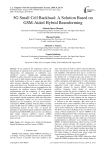
5G small cell backhaul: a solution based on GSM-aided hybrid beamforming
Статья научная
In the proposed 5G architecture where cell densification is expected to be used for network capacity enhancement, the deployment of millimetre wave (mmWave) massive multiple-input multiple-output (MIMO) in urban microcells located outdoor is expected to be used for high channel capacity small cell wireless traffic backhauling as the use of copper and optic-fibre cable becomes infeasible owing to the high cost and issues with right of way. The high cost of radio frequency (RF) chain and its prohibitive power consumption are big drawbacks for mmWave massive MIMO transceiver implementation and the complexity of using optimal detection algorithm as a result of inter-channel interference (ICI) as the base station antenna approaches large numbers. Spatial modulation (SM) and Generalized Spatial Modulation (GSM) are new novel techniques proposed as a low-complexity, low cost and low-power-consumption MIMO candidate with the ability to further reduce the RF chain for mmWave massive MIMO hybrid beamforming systems. In this work, we present the principles of generalized spatial modulation aided hybrid beamforming (GSMA-HBF) and its use for cost-effective, high energy efficient mmWave massive MIMO transceiver for small cell wireless backhaul in a 5G ultra-dense network.
Бесплатно
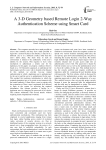
A 3-D Geometry based Remote Login 2-Way Authentication Scheme using Smart Card
Статья научная
The computer networks have made possible to access data remotely and they have made possible to login into a system located at far distance; it may be in a different city or in a different country other than the user's native place. The main issue in such an environment is related to the authenticity of the user's identity by the system. This requires to have some mechanism to authenticate a remote user for his legitimacy. In this paper, we propose a method, which is based on a 3-D Geometric approach, to authenticate the login request sent by a user, who is located at far distance. In this method, we provide two-way mutual authentication in which a legitimate user is authenticated by the server and the server is authenticated by the user. This method first performs initialization in which the required parameters are set to create an environment with the central authority. It then allows a user to register with the system/server. Once a user is registered, he is allowed to login to the system for accessing the required information. Our scheme provides a facility to a legitimate user for changing his password of his choice. This scheme withstands with several attacks without requiring much computational overhead.
Бесплатно
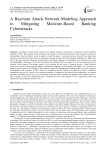
A Bayesian Attack-Network Modeling Approach to Mitigating Malware-Based Banking Cyberattacks
Статья научная
According to Cybersecurity Ventures, the damage related to cybercrime is projected to reach $6 trillion annually by 2021. The majority of the cyberattacks are directed at financial institutions as this reduces the number of intermediaries that the attacker needs to attack to reach the target - monetary proceeds. Research has shown that malware is the preferred attack vector in cybercrimes targeted at banks and other financial institutions. In light of the above, this paper presents a Bayesian Attack Network modeling technique of cyberattacks in the financial sector that are perpetuated by crimeware. We use the GameOver Zeus malware for our use cases as it’s the most common type of malware in this domain. The primary targets of this malware are any users of financial services. Today, financial services are accessed using personal laptops, institutional computers, mobile phones and tablets, etc. All these are potential victims that can be enlisted to the malware’s botnet. In our approach, phishing emails as well as Common Vulnerabilities and Exposures (CVEs) which are exhibited in various systems are employed to derive conditional probabilities that serve as inputs to the modeling technique. Compared to the state-of-the-art approaches, our method generates probability density curves of various attack structures whose semantics are applied in the mitigation process. This is based on the level exploitability that is deduced from the vertex degrees of the compromised nodes that characterizes the probability density curves.
Бесплатно
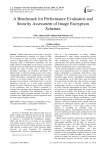
A Benchmark for Performance Evaluation and Security Assessment of Image Encryption Schemes
Статья научная
Digital images have become part of everyday life by demonstrating its usability in a variety of fields from education to space research. Confidentiality and security of digital images have grown significantly with increasing trend of information interchange over the public channel. Cryptography can be used as a successful technique to prevent image data from unauthorized access. Keeping the nature of image data in mind, several encryption techniques are presented specifically for digital images, in literature during past few years. These cryptographic algorithms lack a benchmark for evaluation of their performance, cryptographic security and quality analysis of recovered images. In this study, we have designed and developed a benchmark based on all the parameters necessary for a good image encryption scheme. Extensive studies have been made to categories all the parameters used by different researchers to evaluate their algorithms and an optimum benchmark for evaluation is formulated. This benchmark is used to evaluate three image encryption schemes. The results of evaluation have highlighted the specific application areas for these image encryption schemes.a
Бесплатно
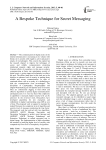
A Bespoke Technique for Secret Messaging
Статья научная
The communication of digital assets on the internet infrastructure is increasing in its volume with threats on its security with regard to active and passive attacks of eavesdroppers. This concern has opened up the research channel to improve the techniques of secure and reliable communication protecting intellectual property rights and message security. Constant efforts of researchers in this area to achieve communication at faster rate maintaining security of digital assets, is giving improved techniques to achieve the goal. The efforts made here in this work are in the direction to enhance level of security in making faster reliable and secure communication. In spite of continued efforts, still as on today, it is challenging to hide the communication from eavesdropper. The disciplines of Cryptography, Steganography and Digital Watermarking are still popular areas of research. They are continuously digging to find robust and effective algorithms to protect digital communications and digital assets. It is very true that if the complexity in algorithm is increased, higher security level can be achieved. In the reviewed work, Researchers have developed algorithms for text encryption and embedment in digital watermarking using LSB at cost of time. The proposed work is targeted to maintain the tradeoff between the complexity level of algorithm and security level of message considering the time factor. The proposed work has evolved with two algorithms: AMEADT (ASCII Message Encryption and Decryption Technique) to protect secret message and AMEAET (ASCII Message Embedment and Extraction Technique) to embed encrypted text to digital image. The implementation of these algorithms has resulted in justifying higher level of security with comparatively lower level of complexity of algorithm.
Бесплатно
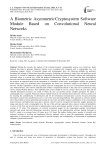
A Biometric Asymmetric Cryptosystem Software Module Based on Convolutional Neural Networks
Статья научная
During the research, the analysis of the existing biometric cryptographic systems was carried out. Some methods that help to generate biometric features were considered and compared with a cryptographic key. For comparing compact vectors of biometric images and cryptographic keys, the following methods are analyzed: designing and training of bidirectional associative memory; designing and training of single-layer and multilayer neural networks. As a result of comparative analysis of algorithms for extracting primary biometric features and comparing the generated image to a private key within the proposed authentication system, it was found that deep convolutional networks and neural network bidirectional associative memory are the most effective approach to process the data. In the research, an approach based on the integration of a biometric system and a cryptographic module was proposed, which allows using of a generated secret cryptographic key based on a biometric sample as the output of a neural network. The RSA algorithm is chosen to generate a private cryptographic key by use of convolutional neural networks and Python libraries. The software authentication module is implemented based on the client-server architecture using various internal Python libraries. Such authentication system should be used in systems where the user data and his valuable information resources are stored or where the user can perform certain valuable operations for which a cryptographic key is required. Proposed software module based on convolutional neural networks will be a perfect tool for ensuring the confidentiality of information and for all information-communication systems, because protecting information system from unauthorized access is one of the most pressing problems. This approach as software module solves the problem of secure generating and storing the secret key and author propose combination of the convolutional neural network with bidirectional associative memory, which is used to recognize the biometric sample, generate the image, and match it with a cryptographic key. The use of this software approach allows today to reduce the probability of errors of the first and second kind in authentication system and absolute number of errors was minimized by an average of 1,5 times. The proportion of correctly recognized images by the comparating together convolutional networks and neural network bidirectional associative memory in the authentication software module increased to 96,97%, which is on average from 1,08 times up to 1,01 times The authors further plan a number of scientific and technical solutions to develop and implement effective methods, tools to meet the requirements, principles and approaches to cybersecurity and cryptosystems for provide integrity and confidentiality of information in experimental computer systems and networks.
Бесплатно
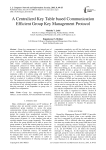
A Centralized Key Table based Communication Efficient Group Key Management Protocol
Статья научная
Group key management is an integral part of secure multicast. Minimizing the number of rekeying messages, maintaining the forward and backward secrecy has always been a challenging task. Though there are many solutions which reduce the rekeying messages from Ο(n) to Ο(log_2?〖n),〗 they increase with the increase in group size. In this paper, we present a centralized key table based communication efficient group key management protocol in which number of rekeying messages is independent of the group size. In this protocol key management server (KMS) divides a group of n members into n subgroups of size n-1 and maintains a table of n subkeys along with member ID and one group key. Each member has n-1 subkeys, which is a subset of n subkeys of KMS and one group key. The proposed protocol requires only one multicast rekeying message per joining of a new member as well as per eviction of any existing member. As the number of rekeying messages is not dependent on group size, it requires less computation.
Бесплатно
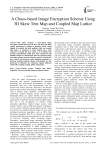
A Chaos-based Image Encryption Scheme Using 3D Skew Tent Map and Coupled Map Lattice
Статья научная
This paper proposes a chaos-based image encryption scheme where one 3D skew tent map with three control parameters is utilized to generate chaotic orbits applied to scramble the pixel positions while one coupled map lattice is employed to yield random gray value sequences to change the gray values so as to enhance the security. Experimental results have been carried out with detailed analysis to demonstrate that the proposed image encryption scheme possesses large key space to resist brute-force attack and possesses good statistical properties to frustrate statistical analysis attacks. Experiments are also performed to illustrate the robustness against malicious attacks like cropping, noising, JPEG compression.
Бесплатно

A Cluster based Key Management Scheme for Underwater Wireless Sensor Networks
Статья научная
Underwater Wireless Sensor Networks (UWSNs) explore aquatic environment to facilitate various underwater surveillance applications. However, UWSN unique features also impose new challenges such as limited bandwidth, huge propagation delay, mobile nature of nodes and high error rates. UWSNs deployment in unattended environment further exacerbates their vulnerabilities to the attacks. These challenges make security solutions proposed for Wireless Sensor Network (WSN) impractical to be applicable for UWSN. This paper analyzes the problem of security and mobility in UWSN and proposes Cluster based Key management Protocol (CKP), a new key management protocol for hierarchical networks where sensor nodes form cluster around more capable nodes. CKP also proposes a new communication architecture that handles mobility efficiently and minimizes the impact of a node compromisation to itself. CKP provides confidentiality, authentication, integrity and freshness. The performance evaluation demonstrates that the CKP is energy and storage-efficient. Further, we investigate the survivability and the security of the CKP against various security threats in order to evaluate its effectiveness.
Бесплатно
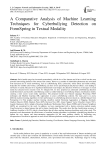
Статья научная
Social media usage has increased tremendously with the rise of the internet and it has evolved into the most powerful networking platform of the twenty-first century. However, a number of undesirable phenomena are associated with increased use of social networking, such as cyberbullying (CB), cybercrime, online abuse and online trolling. Especially for children and women, cyberbullying can have severe psychological and physical effects, even leading to self-harm or suicide. Because of its significant detrimental social impact, the detection of CB text or messages on social media has attracted more research work. To mitigate CB, we have proposed an automated cyberbullying detection model that detects and classifies cyberbullying content as either bullying or non-bullying (binary classification model), creating a more secure social media experience. The proposed model uses Natural Language Processing (NLP) techniques and Machine Learning (ML) approaches to assess cyberbullying contents. Our main goal is to assess different machine learning algorithms for their performance in cyberbullying detection based on a labelled dataset from Formspring [1]. Nine popular machine learning classifiers namely Bootstrap Aggregation or Bagging, Stochastic Gradient Descent (SGD), Random Forest (RF), Decision Tree (DT), Linear Support Vector Classifier (Linear SVC), Logistic Regression (LR), Adaptive Boosting (AdaBoost), Multinomial Naive Bayes (MNB) and K-Nearest Neighbour (KNN) are considered for the work. In addition, we have experimented with a feature extraction method namely CountVectorizer to obtain features that aid for better classification. The results show that the classification accuracy of AdaBoost classifier is 86.52% which is found better than all other machine learning algorithms used in this study. The proposed work demonstrates the effectiveness of machine learning algorithms in automatic cyberbullying detection as against the very intense and time-consuming approaches for the same problem, thereby by facilitating easy incorporation of an effective approach as tools across different platforms enabling people to use social media safely.
Бесплатно
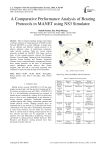
A Comparative Performance Analysis of Routing Protocols in MANET using NS3 Simulator
Статья научная
Due to frequent topology changes and routing overhead, selection of routing protocol in Mobile Ad-hoc Network (MANET) is a great challenge. A design issue for an efficient and effective routing protocol is to achieve optimum values of performance parameters under network scenarios. There are various routing protocols available for MANET. This paper involves study of four routing protocols (Ad-hoc On Demand Distance Vector Routing, Optimized Link State Routing, Dynamic Source Routing and Distance Sequenced Distance Vector), and performance comparisons between these routing protocols on the basis of performance metrics (throughput, packet delivery ratio, Packet dropped, jitter and end to end delay measured after simulation of network) with the help of NS3 Simulator.
Бесплатно
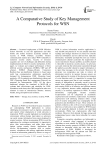
A Comparative Study of Key Management Protocols for WSN
Статья научная
Increased employment of WSN (Wireless Sensor Network) in real life applications and their hostile and remote locations accelerate demand of security in WSN. Publicly accessible wireless communication channel also makes WSN vulnerable to numerous security attacks. Scarcity of resources acquaints new sort of challenges and difficulties during implementation of effective security mechanisms. In this paper, we evaluate and compare performance of three different security mechanisms (ECRKS, CKP and AP scheme). ECRKS (Energy-efficient, Connected, Resilient Key pre-distribution Scheme) is based upon multi hop communication architecture specifically designed for homogeneous WSN. Clustering based protocols, AP (Asymmetric pre-distribution) scheme and CKP (Clustering based Key management Protocol) are proposed for heterogeneous WSN. All the above mentioned schemes are simulated in MATLAB to evaluate their effectiveness and suitability for WSN. Simulation result shows that CKP outperforms other two schemes in terms of transmission distance, memory burden, energy dissipation and resilience.
Бесплатно
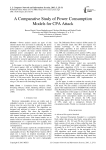
A Comparative Study of Power Consumption Models for CPA Attack
Статья научная
Power analysis attacks are types of side channel attacks that are based on analyzing the power consumption of the cryptographic devices. Correlation power analysis is a powerful and efficient cryptanalytic technique. It exploits the linear relation between the predicted power consumption and the real power consumption of cryptographic devices in order to recover the correct key. The predicted power consumption is determined by using the appropriate consumption model. Until now, only a few models have been proposed and used. In this paper, we describe the process to conduct the CPA attack against AES on SASEBO-GII board. We present a comparison between the Hamming Distance model and the Switching Distance model, in terms of number of power traces needed to recover the correct key using these models. The global successful rate achieves 100% at 11100 power traces. The power traces needed to recover the correct key have been decreased by 12.6% using a CPA attack with Switching Distance model.
Бесплатно
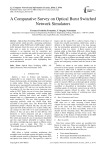
A Comparative Survey on Optical Burst Switched Network Simulators
Статья научная
Optical Burst Switching (OBS) is the future of optical internet which provides a promising architecture to efficiently utilize WDM and to fulfill today’s Internet traffic demands. Since this area is yet to mature there is a darn need to study its various protocols. Network simulator is an important tool for researchers and academicians to simulate and model the actual network at a reduced cost compared to the real test-bed experimentation. In this paper various OBS simulators are comparatively surveyed, while highlighting their merits and demerits.
Бесплатно
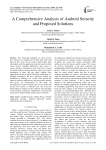
A Comprehensive Analysis of Android Security and Proposed Solutions
Статья научная
The increasing popularity of smart devices have led users to complete all of their daily work with these devices. Users are now able to shop online, share information with the applications that they install on their smart devices. Installed applications gain access to various sensitive information, such as the user's contact list, phone number, location. However, there is no control mechanism in place that can check whether these applications are safe to install. Therefore, applications are installed according to the users' decisions, without any limitations or warnings. As a result, users become the target of malicious applications, and the personal security and privacy are compromised. In this study, we investigate the security solutions that aim to protect the privacy and security of Android users. We reveal the shortcomings of mobile security solutions and shed light on the research community. Additionally, we present the taxonomy of Android-based mobile security solutions.
Бесплатно
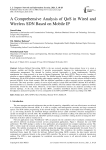
A Comprehensive Analysis of QoS in Wired and Wireless SDN Based on Mobile IP
Статья научная
Software-Defined Networking (SDN) is the new network paradigm whose primary focus is to create a dynamic, scalable and flexible network. It provides programmable functions for implementation of network configuration management. The demand for wireless network functionality is rising simultaneously. Mobility management for a large network is an issue in Internet Engineering Task Force (IETF). There are also a number of solutions to support mobility within the network. The Mobile Internet Protocol (MIP) is used for managing mobility. Furthermore, for the SDN platform, mobility adds roaming capability for mobile nodes in the software-defined wireless network (SDWN). In the wired scenario, SDN has different capabilities to deliver network services according to the fixed node. This study provides a quality of service (QoS) analysis in both SDN and SDWN. Mininet WiFi and RYU network emulator as a controller is used to implement the mobility API. The random walk model is applied as mobility functionality toward the final nodes. Moreover, several QoS measurement matrices are analyzed according to the network topology. At the end, round trip time (RTT), cumulative distributed function (CDF), packet loss and throughput are analyzed for quality of service comparable in the SDN and SDWN scenarios according to the MIP.
Бесплатно
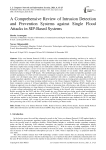
Статья научная
Voice over Internet Protocol (VoIP) is a recent voice communication technology and due to its variety of calling capabilities, the system is expected to fuel the market value even further in the next five years. However, there are serious concerns since VoIP systems are frequently been attacked. According to recent security alliance reports, malicious activities have increased largely during the current pandemic against VoIP and other vulnerable networks. This hence implies that existing models are not sufficiently reliable since most of them do not have a hundred percent detection rate. In this paper, a review of our most recent Intrusion Detection & Prevention Systems (IDPS) developed is proposed together with a comparative analysis. The final work consisted of ten models which addressed flood intentional attacks to mitigate VoIP attacks. The methodological approaches of the studies included the quantitative and scientific paradigms, for which several instruments (comparative analysis and experiments) were used. Six prevention models were developed using three sorting methods combined with either a modified galloping algorithm or an extended quadratic algorithm. The seventh IDPS was designed by improving an existing genetic algorithm (e-GAP) and the eighth model is a novel deep learning method known as the Closest Adjacent Neighbour (CAN). Finally, for a better comparative analysis of AI-based algorithms, a Deep Analysis of the Intruder Tracing (DAIT) model using a bottom-up approach was developed to address the issues of processing time, effectiveness, and efficiency which were challenges when addressing very large datasets of incoming messages. This novel method prevented intruders to access a system without authorization and avoided any anomaly filtering at the firewall with a minimum processing time. Results revealed that the DAIT and the e-GAP models are very efficient and gave better results when benchmarking with models. These two models obtained an F-score of 98.83%, a detection rate of 100%, a false rate of 0%, an accuracy of 98.7%, and finally a processing time per message of 0.092 ms and 0.094 ms respectively. When comparing with previous models in the literature from which it is specified that detection rates obtained are 95.5% and false-positive alarm of around 1.8%, except for one recent machine learning-based model having a detection rate of 100% and a processing time of 0.53 ms, the DAIT and the e-GAP models give better results.
Бесплатно

